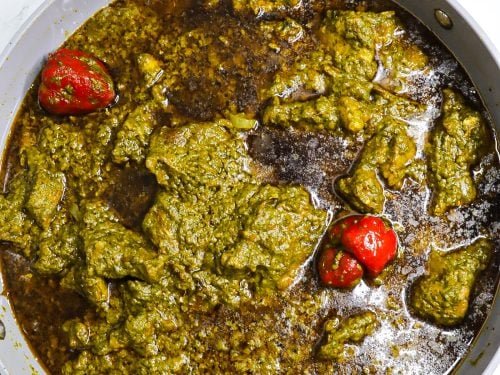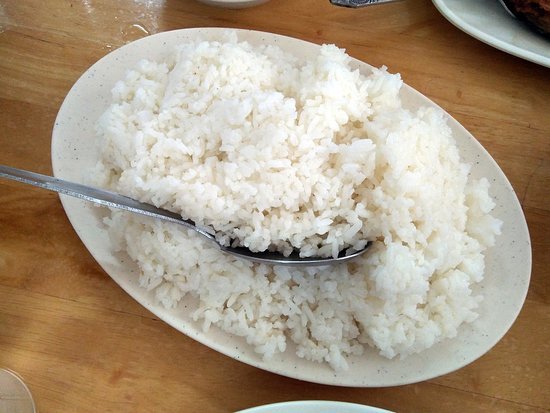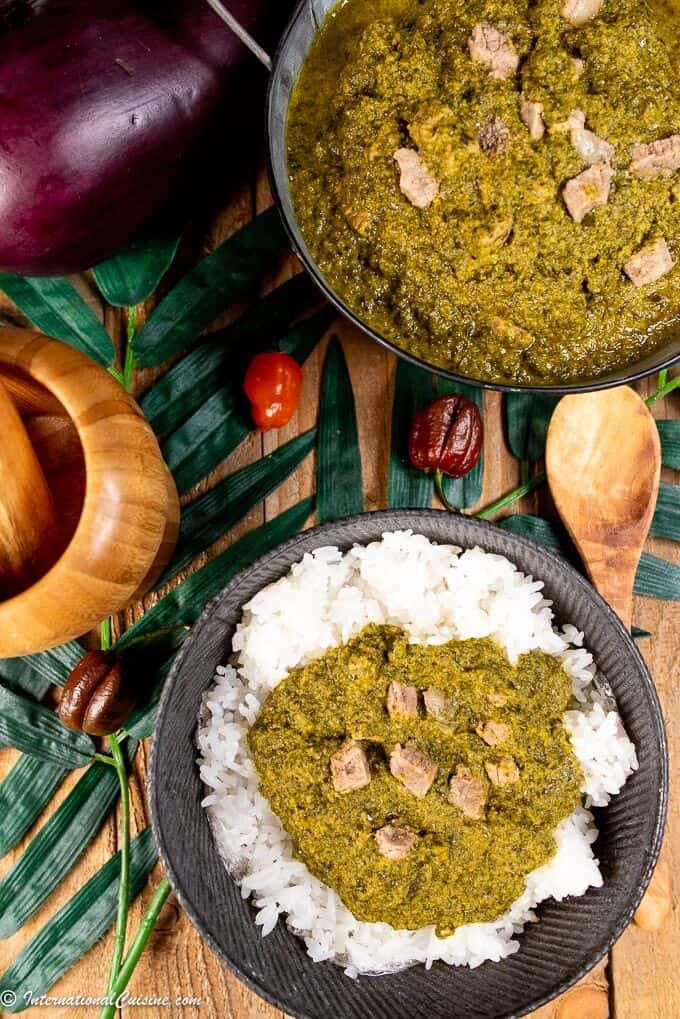Stews are a fundamental part of Sierra Leone’s cuisine, with cassava leaves having been called the country’s national dish. Stew is often served with jollof rice, white rice or snacks such as plantain, akara (bean ball), yam, or cassava.
Cassava leaf stew goes by several different names like saka saka, pondu, palava, and mpondu. It is always served over steamed rice and is considered to be the national dish of Sierra Leone.
Cassava leaf stew is also extremely popular in other West African countries as well as parts of Central Africa like the Central African Republic and the Congo.
This version is made with beef and smoked fish but there are numerous versions with chicken and just fish and completely vegetarian. Goat meat is often used too. I loved this recipe as it was well rounded and a delight for the palate. It is also very filling. It has eggplant in it as well. In Sierra Leone, they would use a mortar and pestle called a mata wodo.
A platter of cassava leaf stew over rice.
White rice is a staple ingredient in Sierra Leone and they have a saying “If you haven’t eaten rice today, you haven’t eaten”. It just proves how important it is in the cuisine.
This dish along with other stews are typically served on a large platter and served communally. After a hand washing, you would sit down and using only your right hand make a ball with the rice and make an indentation with your thumb. This basically turns the rice into a spoon to sop up the delicious cassava leaf stew.
How to Cook Cassava Leaves Stew

Get your hands on some cassava leaves and treat yourself to West African comfort food at its finest. Although you’ve probably seen more meals that use the cassava root, you can eat the leaves as long as you grind them and cook them thoroughly. Simmering the leaves makes a thick stew, which is sometimes called cassava or soup. Many African countries put their own take on stewing the leaves, so try your hand at a basic version and customize it by swapping out meat, adding dried fish, or using your favorite seasonings.
Basic Stewed Cassava Leaves
- 1 pound (450 g) of boneless meat
- 1 tablespoon (15 ml) of vegetable oil
- Ground pepper, to taste
- 2 onions, peeled and roughly chopped, divided
- 2 stock cubes like Maggi
- 3 cups (0.71 L) of water, divided
- 2 eggplants, peeled and roughly chopped
- 1⁄4 pound (110 g) of dried smoked fish or 3 tablespoons (42 g) of crayfish powder
- 1 Scotch bonnet or another chili to taste
- 5 tablespoons (75 g) of smooth peanut butter
- 1⁄2 cup (120 ml) of palm oil
- 1.1 pounds (0.50 kg) of pounded frozen cassava leaves, thawed
- 4 cloves of garlic, optional
Cut 1 pound (450 g) of boneless meat into bite-sized cubes. You can use any meat that’s available. Try beef, chicken, turkey, or goat, for instance. Just make sure to cut them into evenly sized-pieces so they cook at the same rate.
Want to make vegetarian cassava leaves? No problem— just leave out the meat and skip the dried fish.
Put the meat into a pot along with vegetable oil, onion, stock, and water. Set a big pot on the stove and put the meat cubes into it along with 1 tablespoon (15 ml) of vegetable oil and a pinch of salt and pepper. To really give the meat some flavor, add 1 of the stock cubes and 1 tablespoon (6 g) of chopped onion before you pour in 1⁄3 cup (79 ml) of the water.
- Feel free to add up to 4 cloves of chopped garlic to the pot for a richer flavor.
Bring the water to a boil. Turn the burner to medium-high and keep the lid off of the pot so you can see when the water starts boiling— it won’t take long
Simmer the meat for 25 minutes or until it’s tender. Turn the burner down to medium and pop the lid on the pot. Simmer the meat until it’s completely cooked and tender. Stir the meat occasionally to help it cook evenly.[4]
- Use a slotted spoon to scoop the meat into a dish and set it aside. You can leave the liquid in the pot to add to the vegetables later.
Making the Vegetable Base
Put eggplants, onions, flaked fish, chili, and water into a blender. While you could pound all of these ingredients by hand, the blender really speeds things up! Put 2 roughly chopped eggplants into a blender along with 2 chopped onions, and 1 Scotch bonnet (or your favorite type of chili pepper). If you want to use smoked fish, get out 1⁄4 pound (110 g) of piece and flake it before you drop it into the blender. Then, pour in 2⁄3 cup (160 ml) of water.
Can’t get ahold of dried fish? You can substitute 3 tablespoons (42 g) of crayfish powder to get that deep, seafood flavor.
Pulse the ingredients until they’re smooth. Pop the lid on the blender and pulse until all of the vegetables are blended and you can’t see any chunks of dried fish. You might have to stop and scrape down the sides of the blender a few times. Keep blending until your flavorful mixture is totally smooth
Some people like to add a few diced tomatoes to brighten the flavor of the dish. You can use fresh tomatoes or open a can and add the diced tomatoes to the blender.
Pour the purée into a pot with a stock cube, water, peanut butter, and palm oil. Put another big pot on the stove and spoon the flavorful purée into it. Then, drop in your remaining stock cube and pour in 1 1⁄2 cups (0.35 L) of water. Stir in 5 tablespoons (75 g) of smooth peanut butter and 1⁄2 cup (120 ml) of palm oil to finish the base for your cassava leaf stew
If you don’t have peanut butter in your pantry, grind up any ground nuts you have until they’re fine and add them to the base. The peanut butter or ground nuts help thicken the stew so don’t leave it out!
Don’t want to use palm oil? Try substituting the same amount of coconut oil. Instead of having a savory or earthy flavor, coconut oil has a mild, delicate flavor that also works well with cassava leaves.
Bring the mixture to a boil and simmer it for 30 minutes. Turn the burner to high so the water starts to boil. Then, turn the burner down to medium so it bubbles gently. Keep the lid off of the pot so some of the water evaporates and your stew thickens
Stir the pot occasionally so it doesn’t scorch on the bottom of the pot.
Assembling the Stew
1. Put thawed cassava leaves into a strainer and rinse them with cold water. Open a 1.1 lb (0.50 kg) package of pounded cassava leaves that you’ve thawed and put them into a fine-mesh strainer. Take it over to the sink and run cold water over it to rinse away any sand or grit.
Check the freezer aisles of your local African or ethnic market for ground cassava leaves. Still can’t find them? It’s fine to substitute the same amount of chopped spinach.
2. Add the cassava leaves and liquid from the meat to the vegetables in the pot. Put your cassava leaves right into the simmering vegetable base you’ve got cooking on the stove and add the liquid that’s in the pot with the meat. It will add a ton of flavor to your cassava leaves.
Wait to add the cooked meat into the cassava stew since you don’t want it to become tough.
3. Simmer the stew for at least 30 minutes. Turn the burner to high and keep the lid off of the pot. Once it starts bubbling, turn the burner down to medium and let it bubble gently for at least 30 minutes. Keep the pot covered, but stir the stew occasionally until it’s very thick like porridge.
Your cassava leaves might absorb a lot of water, so pour in more if they start to stick to the bottom of the pan.
4. Add the cooked meat to the cassava leaf stew. When the cassava leaf stew is almost as thick as you like, put the meat you cooked earlier into the pot and stir it well. You can also taste the stew and adjust the seasonings.
5. Simmer the cassava for 10 more minutes. Let the stew bubble gently for 10 minutes over medium heat so the meat warms back up and the flavors meld. Then, serve the stew with steamed rice
Refrigerate leftover cassava leaf stew in an airtight container for up to 4 days.
If you can buy fresh cassava leaves from your local market, pound them finely in a mortar and pestle or grind them in a blender. Then, soak the cassava leaves in water before you drain them and add them to your stew.
After making the cassava stew the next thing to make is your rice. I believe you already know how to make your rice right ?
Source: International Cuisine,





